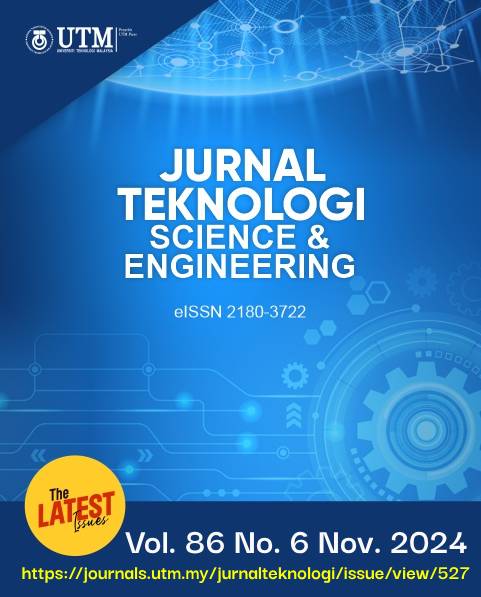GROWING OF GREEN CORAL LETTUCE AND RED HYBRID TILAPIA IN COMPACT AQUAPONIC PROTOTYPE AT DIFFERENT RECIRCULATION RATES
DOI:
https://doi.org/10.11113/jurnalteknologi.v86.21427Keywords:
Aquaponics, green salad, aquaculture, Tilapia, sustainabilityAbstract
In this work, a compact-size aquaponics prototype was designed and fabricated. One of the current challenges in compact aquaponics systems is optimizing the balance between fish waste production and plant nutrient uptake. The objective of the work is to assess the impact of different pump recirculation rates on the crops cultivation at such compact aquaponics unit. Main components included a 50 litres fish tank, a filter unit that combines the mechanical filter and biological filter counterparts, and nutrient film technique (NFT) grower. Production of food was carried out for 10 weeks at two different recirculation rates i.e. at 50 L/hr and 75L/hr. According to the data attained, the specific growth rate (SGR) was around 5.4-5.7% with a food conversion ratio (FCR) of about 1.8-2. Moreover, the fish survival rate was 80%, and plant growth yield is about 1.5-2 cm/week. Although the level of ammonia was slightly off the acceptable limit, no yellowish colour on the leaves of the green coral lettuce was observed. The data attained signify the successful operation of compact-size aquaponics for the production of organic leafy plants and freshwater aquaculture.
References
Yep, B, Zheng, Y. 2019. Aquaponic Trends and Challenges – A Review. Journal of Cleaner Production. 228: 1596-1599.
Spradlin, A, Saha, S. 2022. Saline Aquaponics: A Review of Challenges, Opportunities, Components, and System Design. Aquaculture. 555: 738173.
Getachew, B., Kiros, H., Habtu, E. 2018. Review on Aquaponics System for Fish Farming. World Journal of Fish and Marine Sciences. 10 (5): 59-68.
Shultz, R. C., Coyle, S. D., Bright, L. A, Hager, J. V., Tidwell. J. H. 2022. Evaluation of Different Artificial Light Technologies for Indoor Aquaponic Production of Bibb Lettuce, Lactuca sativa var. capitata, and compact basil, Ocimum basilicum var. Genovese. Journal of World Aquaculture Society. 53: 703-713.
Pérez-Urrestarazua, L., Lobillo-Eguíbarb, J., Fernández-Cañerob, R., Fernández-Cabanás, V. M. 2019 Suitability and Optimization of FAO’s Small-Scale Aquaponics Systems for Joint Production of Lettuce (Lactuca sativa) and Fish (Carassius auratus). Aquacultural Engineering. 85: 129-137.
Simeonidou, M., Paschos, I., Gouva, E., Kolygas, M., Perdikaris, C. 201). Performance of a Small-scale Modular Aquaponic System. International Journal of the Bioflux Society. 5(4): 182-188.
Zainal Alam, M. N. H., Ali Othman, N. S. I., Samsudin, S. A., Johari, A., Hassim, M. H., and Kamaruddin, M. J. 2020. Carbonized Rice Husk and Cocopeat as Alternative Media Bed for Aquaponic System. Sains Malaysiana. 49(3): 482-492.
Selek, M., Endo, M., Yigit, M., Takeuchi, T. 2017. The Integration of Fish and Plant Production: Nile tilapia (Oreochromis niloticus) and Basil (Ocimum basilicum) Culture in Recirculating and Aquaponics Systems. J. Aquaculture Engineering Fish Resources. 3(1): 28-43.
Yildiz, H. Y., Robaina, L., Pirhonen, J., Mente, E., Dominguez, D., Parisi, G. 2017. Fish Welfare in Aquaponics Systems: Its Relation to Water Quality with Emphasis on Feed and Faeces - A Review. Water. 9(13). Doi:10.3990/w9010013.
Filep, R. M., Diaconescu, S., Marin, M., Badulescu, L., Nicolae, C. G. 2016. Case Sstudy on Water Quality Control in an Aquaponic System. Current Trends in Natural Sciences. 5(9): 6-9.
Gosh, K., Chowdhury, S. 2019. Review of Aquaponics System: Searching for a Technically Feasible and Economically Profitable Aquaponics System. Journal of Agricultural Environmental and Consumer Sciences. 19: 5-13.
Zainal Alam, M. N. H., Kamaruddin, M. J., Samsudin, S. A., Othman, R., Mohammad Radzi, N. H., Emmanuel, A. A., Zainal Abidin, M. S. 2023. Smart Farming using a Solar-Powered Aquaponics System for Sustainable Food Production. Malaysian Journal of Science. 42(1): 68-77.
König, B., Janker, J., Reinhardt, T., Villarroel, M., Junge, R., 2018. Analysis of Aquaponics as an Emerging Technological Innovation System. J. Clean. Prod. 180: 232-243. https://doi.org/10.1016/J.JCLEPRO.2018.01.037.
Delaide, B., Delhaye, G., Dermience, M., Gott, J., Soyeurt, H., Jijakli, M. H. 2017. Plant and Fish Production Performance, Nutrient Mass Balances, Energy and Water Use of the PAFF Box, a Small-scale Aquaponic System. Aquaculture Engineering. 78: 130-139.
Maucieri, C., Nicoletto, C., Junge, R., Schmautz, Z., Sambo, P., Borin, M. 2017. Hydroponic Systems and Water Management in Aquaponics: A Review. Ital. J. Agron. 11. https://doi.org/10.4081/ija.2017.1012.
Palm, H. W., Knaus, U., Appelbaum, S., Goddek, S., Strauh, S. M., Vermeulen, T., Jijakli, M. H., and Kotzen, B. 2018. Towards Commercial Aquaponics: A Review of Systems, Designs, Scales and Nomenclature. Aquacultural International. 26: 813-842.
Wirza, R. and Nazir, S. 2020. Urban Aquaponics Farming and Cities-a Systematic Literature Review. Reviews on Environmental Health. 36: 47-61.
Adzman, N., Samsudin, S. A., Alam, M. N. H. Z., Othman, N. S. I. A., Kamaruddin, M. J. 2021. Intermittent Water Pump Operation to Reduce Energy Consumption of Aquaponics System. Chemical Engineering Transactions. 89: 283-288.
Trang, N. T. D., Konnerup, D., & Brix, H. 2017. Effects of Recirculation Rates on Water Quality and Oreochromis niloticus Growth in Aquaponic Systems. Aquacultural Engineering. 78(B): 95-104.
Yeşiltaş, M., Koçer, M. A. T., Sevgili, H., & Koru, E. 2021. Effect of Different Inorganic Substrates on Growth Performance of African Catfish (Clarias gariepinus, Burchell 1822) and Lettuce (Lactuca sativa L.). Turkish Journal of Agriculture-Food Science and Technology. 9(4): 714-722.
Xu, L., Ziethen, C. J., Appelbaum, S., Palm, H. W., & Knaus, U. 2022. Aquaponics Production of Wheatgrass (Triticum aestivum L.) in Different Horticultural Substrates with African Catfish (Clarias gariepinus) in Northern Germany. AgriEngineering. 4(4): 1076-1094.
Downloads
Published
Issue
Section
License
Copyright of articles that appear in Jurnal Teknologi belongs exclusively to Penerbit Universiti Teknologi Malaysia (Penerbit UTM Press). This copyright covers the rights to reproduce the article, including reprints, electronic reproductions, or any other reproductions of similar nature.
















